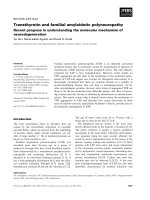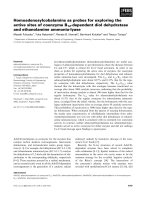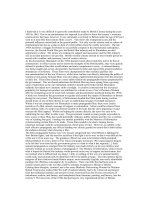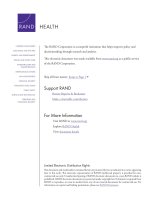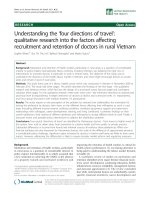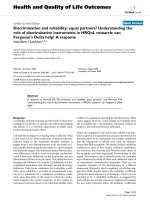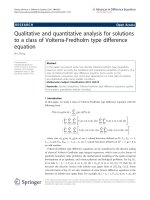Integrating population genomics and medical genetics for understanding the genetic aetiology of eye traits
Bạn đang xem bản rút gọn của tài liệu. Xem và tải ngay bản đầy đủ của tài liệu tại đây (3.07 MB, 215 trang )
INTEGRATING POPULATION GENOMICS AND MEDICAL
GENETICS FOR UNDERSTANDING THE GENETIC
AETIOLOGY OF EYE TRAITS
FAN QIAO
(M.Sc. University of Minnesota)
A THESIS SUBMITTED FOR THE DEGREE OF DOCTOR OF
PHILOSPHY
SAW SWEE HOCK SCHOOL OF PUBLIC HEALTH
NATIONAL UNIVERSITY OF SINGAPORE
2012
Acknowledgements
I would like to express my sincerest gratitude to my supervisor, Prof. Yik-
Ying Teo, for his guidance, patience and encouraging high standards in my
work through this study. He spent hours reviewing my original manuscripts,
gave constructive feedback and made detailed corrections. His support has
been invaluable for me to write this doctoral thesis.
I am also deeply grateful to my supervisor, Prof. Seang-Mei Saw, for her
continuous support, suggestions and providing research resources for me to
accomplish my work. Her passion in research and the determination to slow
the myopic progression in children has influenced me greatly.
My sincere thanks also go to Dr. Yi-Ju Li, who encouraged me to move a
step forward in my career and broadened my research experience. Her
unflinching courage confronting ill health will inspire me for my whole life. I
am also thankful to Dr. Ching-Yu Cheng. The conversations with Ching-Yu
were always valuable for me to understand the clinical relevance of ocular
diseases. My thanks are also due to Dr. Chiea-Chuen Khor for his prompt
comments in reviewing my papers and the insight provided. I also wish to
thank Dr. Liang Kee Goh for providing the infrastructure to support me at the
beginning of this research, and Prof. Terri L Young and Prof. Tien-Yin Wong
for their dedication along this project.
During this research, I have worked with many collaborators for whom I
have great regard. In particular, I am indebted to Dr. Veluchamy A. Barathi
for performing gene and protein expression in ocular tissues. The discussion
with her regarding the animal model of myopia was an interesting exploration.
2
It is also my pleasure to acknowledge Dr. Akira Meguro and Dr. Isao Nakata
for kindly sharing their data in the replication study and stimulating
discussions.
Many thanks go to my office-mates and colleagues, Zhou Xin, Chen Peng,
Xiaoyu, Haiyang, Huijun, Rick, Queenie, Vivian, Chenwei and Wang Pei for
their cheerful discussion and a source of inspiration.
Finally, I would like to thank my family for their wholehearted support
given to me - I owe everything to them.
For me, the journey over the past several years has been more like a
process of cultivation. The best way to express my gratitude is, without
attachment to a self, to help others in my life.
3
Tables of Contents
SUMMARY………………………………………………………………… 6
LIST OF TABLES……………………………………………… 8
LIST OF FIGURES………………………………………………… 9
1 CHAPTER 1 INTRODUCTION 12
1.1 Statistical analysis of genome-wide association studies 12
1.1.1 Linkage disequilibrium based association mapping 12
1.1.2 Study design and analytical strategy 13
1.1.2.1 Data quality control 13
1.1.2.2 Population structure 14
1.1.2.3 Study design 16
1.1.2.4 Multiple testing 17
1.1.3 Phenotype classification 18
1.1.3.1 Binary/quantitative traits 18
1.1.3.2 Paired eye measurements 19
1.1.4 Meta-analysis of genome-wide association studies 22
1.1.4.1 Imputation on genotyped data 22
1.1.4.2 Statistics in the meta-analysis 23
1.1.4.3 Statistical challenges in analyzing multi-ethnic populations 26
1.2 Recombination variation between populations 28
1.2.1 Recombination and genetic diversity 28
1.2.2 Variation in inter-population recombination 29
1.2.3 Current approaches of quantifying recombination differences 30
1.3 Refractive errors and the aetiology of myopia 32
1.3.1 Types of refractive errors 33
1.3.1.1 Myopia, hyperopia and ocular biometrics 33
1.3.1.2 Astigmatism 34
1.3.2 Experimental animal myopia models 35
1.3.2.1 Deprivation myopia and inducing myopia 35
1.3.2.2 Emmetropisation and the role of scleral changes in eye growth 37
1.3.2.3 Peripheral refraction 37
1.3.3 Roles of environmental factors in controlling human refraction 38
1.3.4 Genetic basis of myopia 41
1.3.4.1 Familial aggregation and segregation 41
1.3.4.2 Estimates of heritability 43
1.3.5 Genetic loci associated with or linked to refractive errors 46
1.3.5.1 Myopic loci identified from genome-wide linkage studies 46
1.3.5.2 Candidate gene studies 50
1.3.5.3 Genome-wide association studies 57
4
1.3.6 Intervention to slow myopia progression 61
2 CHAPTER 2 STUDY AIMS 65
3 CHAPTER 3 GENETIC VARIANTS ON CHROMOSOME 1Q41
INFLUENCE OCULAR AXIAL LENGTH AND HIGH MYOPIA 67
3.1 Abstract 67
3.2 Background 68
3.3 Methods 70
3.3.1 Study cohorts 70
3.3.2 Data quality control 74
3.3.3 Statistical methods 77
3.3.4 Functional studies 78
3.3.4.1 Gene expression in human 78
3.3.4.2 Myopia-induced mouse model 79
3.4 Results 82
3.4.1 Datasets after quality control 82
3.4.2 Locus at chromosome 1q41 achieved genome-wide significance 83
3.4.3 Association with high myopia on the identified SNPs 84
3.4.4 Gene expression 85
3.5 Discussion 86
4 CHAPTER 4 GENOME-WIDE META-ANALYSIS OF FIVE
ASIAN COHORTS IDENTIFIES PDGFRA AS A SUSCEPTIBILITY
LOCUS FOR CORNEAL ASTIGMATISM 103
4.1 Abstract 103
4.2 Background 104
4.3 Methods 106
4.3.1 Study cohorts 106
4.3.2 Data quality control 109
4.3.3 Statistical methods 113
4.4 Results 115
4.4.1 Datasets after quality control 115
4.4.2 Gene PDGFRA exhibiting genome-wide significance 116
4.5 Discussion 117
5 CHAPTER 5 GENOME-WIDE COMPARISON OF ESTIMATED
RECOMBINATION RATES BETWEEN POPULATIONS 130
5
5.1 Study summary 130
5.2 Methods 131
5.2.1 Development of recombination variation score 131
5.2.2 Simulation 134
5.2.3 Estimation of recombination rates 137
5.2.4 Simulation 138
5.2.5 SNP annotation, copy number variation and F
ST
calculation 141
5.2.6 Quantification of variations in linkage disequilibrium 141
5.3 Results 143
5.3.1 Simulation studies on power and false positive rates 143
5.3.2 Application to HapMap and Singapore Genome Variation Project 145
5.3.3 Recombination variation and Linkage disequilibrium variation highly correlated
148
5.3.4 Regions with largest recombination variation less frequent in genes 149
5.4 Discussion 149
6 CHAPTER 6 CONCLUSION 181
6.1 Identified genetic variants associated with refractive errors 181
6.2 Transferability of the genetic variants for refractive errors across populations
182
6.3 Statistical meta-analysis of GWAS in diverse populations 184
6.4 Missing heritability of myopia 185
6.5 Recombination variations and implications in genetic association studies 187
7 PUBLICATIONS 190
8 REFERENCES 191
6
Summary
For complex human diseases, identifying the underlying genetic factors
has previously primarily relied on either genome-wide linkage scans to narrow
down the chromosomal regions that are linked to disease-causing genes or the
candidate gene approach based on known mechanisms of disease
pathogenesis. During the past few years, genome-wide association studies
have emerged as popular tools to identify genetic variants underlying common
and complex diseases, greatly advancing our understanding of the genetic
architecture of human diseases.
Refractive errors are complex ocular disorders, as the underlying causes
are both genetic and environmental in origin. The need for continued research
into the genetic aetiology of refractive errors is considerable, especially
considering a mismatch between high heritability in twin studies and the
paucity of evidence for associated genetic variation. This thesis seeks to
address the potential roles of genetic factors involved in refractive errors.
Through a meta-analysis of three genome-wide association scans on ocular
biometry of axial length in Asians, we have determined that a genetic locus on
chromosome 1q41 is associated with axial length and high myopia. In
addition, our meta-analysis in five genome-wide association studies in Asians
has revealed that genetic variants on chromosome 4q12 are associated with
corneal astigmatism, exhibiting strong and consistent effects over Chinese,
Malays and Indians.
Inter-population variation in patterns of linkage disequilibrium, largely
shaped by underlying homologous recombination, influences the
transferability of genetic risk loci across different populations. Understanding
7
the recombination variation provides the insight into fine-mapping of the
functional polymorphisms by leveraging on the genetic diversity of different
populations. This motivates an attempt to quantify the recombination
variations between populations. For this purpose, a quantitative measure
(varRecM) is proposed to evaluate the extent of inter-population differences in
recombination rates. Our findings suggest that significant fine-scale
differences exist in the recombination profiles of Europeans, Africans and East
Asians. Regions that emerged with the strongest evidence harbour candidate
genes for population-specific positive selection, and for genetic syndromes.
8
List of Tables
Table 1. Summary of analytic approaches for quantitative trait two-eye data in
genome-wide association studies 21
Table 2. Myopia loci identified from genome-wide linkage studies 49
Table 3. Candidate genes studied for high myopia 54
Table 4. Genetic loci identified from genome-wide association studies 59
Table 5. Characteristics of study participants in the five Asian cohorts 92
Table 6. Top SNPs (P
meta
-value ≤ 1 × 10
-5
) associated with AL from the
meta3analysis in the three Asian cohorts 93
Table 7. Association between genetic variants at chromosome 1q41 and high
myopia in the five Asian cohorts 94
Table 8. Characteristics of the participants in five studies 128
Table 9. Top SNPs (P-value ≤ 5 x 10
-6
) identified from combined meta-
analysis of five Asian population cohorts 129
Table 10. varRecM scores at top percentiles for pair-wise comparisons of the
three HapMap populations between CEU and JPT + CHB, CEU and YRI, YRI
and JPT + CHB 175
Table 11. The 20 strongest signals of varRecM scores in comparisons of
HapMap populations 176
Table 12. The 20 strongest signals of varRecM score in comparison of
populations of SGVP Chinese and Indians, and Chinese and HapMap East
Asians 179
9
List of Figures
Figure 1. Impact of population stratification on genotype frequencies in the
case-control association study 15
Figure 2. Cross-sectional view of the human eye structure …… ………34
Figure 3. The implicated genes likely to be involved in the visual signal
transmission and scleral remodeling…………………………………………61
Figure 4. Principal component analysis (PCA) was performed in SiMES to
assess the extent of population structure 95
Figure 5. Principal Component Analysis (PCA) of discovery cohorts SCES,
SCORM and SiMES with respect to the four population panels in phase 2 of
the HapMap samples (CEU-European, YRI-African, CHB-Chinese, JPT-
Japanese) 96
Figure 6. Quantile-Quantile (Q-Q) plots of P-values for association between
all SNPs and AL in the individual cohort (A) SCES, (B) SCORM,(C) SiMES,
and combined meta-analysis of the discovery cohorts (D) SCES + SCORM +
SiMES 97
Figure 7. Manhattan plot of -log
10
(P) for the association on axial length from
the meta-analysis in the combined cohorts of SCES, SCORM and SiMES 98
Figure 8. The chromosome 1q41 region and its association with axial length
in the Asian cohorts 99
Figure 9. mRNA expression of ZC3H11B, SLC30A10 and LYPLAL1 in
human tissues 100
Figure 10. Transcription quantification of ZC3H11A, SLC30A10 and
LYPLAL1 in mouse retina, retinal pigment epithelium and sclera in induced
myopic eyes, fellow eyes and independent control eyes 101
Figure 11. Immunofluorescent labelling of (A) ZC3H11A (B) SLC30A10 and
(C) LYPLAL1 in mouse retina, retinal pigment epithelium and sclera in
induced myopic eyes, fellow eyes and independent control eyes 102
Figure 12. Principal Component Analysis (PCA) of SP2, SiMES, SINDI,
SCORM with respect to the population panels in phase 2 of the HapMap
samples (CEU-European, YRI-African, CHB-Chinese, JPT-Japan) 122
Figure 13. Principal component analysis (PCA) was performed in SINDI to
assess the extent of population structure 123
10
Figure 14. Quantile-Quantile (Q-Q) plots of P-values for association between
all SNPs and corneal astigmatism in the combined meta-analysis of (A)
individual cohort SP2, (B) SiMES, (C) SINID, (D) SCORM, (E) STARS and
(F) SP2 + SiMES + SINDI + SCORM + STARS 124
Figure 15. (A) Manhattan plot of log
10
(P-values) in the combined discovery
cohort of SP2, SiMES, SINDI, SCORM and STARS. The blue horizontal line
presents the threshold of suggestive significance (P = 1.00 × 10
-5
). (B)
Regional plot of the association signals from the meta-analysis of the five
GWAS cohorts around the PDGFRA gene locus 125
Figure 16. Forest plot of the estimated allelic odds ratios for the lead SNP
rs7677751 126
Figure 17. Linkage disequilibrium (LD) calculated in terms of r
2
for
Singapore Chinese samples from SP2 (A), Malays samples from SiMES (B)
and Indians panels from SINID (C) 127
Figure 18. Illustration of ranking the recombination differences from two
populations 156
Figure 19. Evaluation of false positive rates (FPR) of varRecM method 157
Figure 20. Power performance of varRecM method 158
Figure 21. Accumulative density plots of varRecM scores from five pair
comparisons between HapMap and SGVP populations 159
Figure 22. Distribution of population-specific recombination peak regions in
the top 1% of the varRecM scores 160
Figure 23. Top regions of largest varRecM scores with overlapping signals of
positive selection 161
Figure 24. Plots of the top 20 regions of the varRecM scores for the
comparison between samples of HapMap CEU and JPT+CHB 164
Figure 25. Plots of the top 20 regions of the varRecM scores for the
comparison between samples of HapMap CEU and YRI 166
Figure 26. Plots of the top 20 regions of the varRecM scores for the
comparison between samples of HapMap JPT+CHB and YRI 168
Figure 27. Plots of the top 20 regions of the varRecM scores for the
comparison between samples of SGVP CHS and INS 170
Figure 28. Plots of the top 20 regions of the varRecM scores for the
comparison between samples of SGVP CHS and HapMap JPT+CHB 172
11
Figure 29. Scatter plot of varLD score versus varRecM score among HapMap
and SGVP populations 173
Figure 30. Odds ratio of extreme varRecM scores presenting in intergenic
versus gene regions 174
12
1 Chapter 1 Introduction
In this Chapter, I will initially introduce the genome-wide association
studies (GWAS) and the GWAS meta-analysis, and also highlight the
statistical challenges for paired-eye data. Subsequently, I will provide the
background and motivation of the study in inter-population recombination
variations. The last section will include a literature review on the aetiology of
refractive errors, particularly myopia.
1.1 Statistical analysis of genome-wide association studies
1.1.1 Linkage disequilibrium based association mapping
Mapping disease genes primarily depends on linkage studies and
association mapping. The former exploits within-family correlations between
the disease and the genetic markers (i.e. microsatellite) linked to disease-
related genes by calculating the logarithm of odds (LOD) scores
1
. Mutations
for more than 1,600 Mendelian diseases have been discovered by linkage
studies; however, it is less successful for complex (polygenic) disorders.
The genome-wide design is proposed as a powerful means to identify
common variants that underlie complex human traits
2,3
. GWAS typically
survey between 500,000 to 1,000,000 single nucleotide polymorphisms
(SNPs) across the entire human genome simultaneously
4
. Such a dense set of
SNPs (known as tag SNPs) across the genome is chosen based on the linkage
disequilibrium (LD) pattern of genotyped SNPs within a particular
chromosomal region in HapMap reference samples, thanks to the launch of the
international HapMap project
5
. In the simple scenario, an association study
13
compares the frequency of alleles or genotypes for a particular variant
between the cases and controls. The current design of GWAS relies on genetic
correlations between the genotyped markers and underlying functional
polymorphisms, named LD-mapping. LD is the non-random association of
alleles at two or more loci. The amount of LD depends on the difference
between observed and expected (which is assumed randomly distributed)
allelic frequencies. SNPs in high LD are likely to transmit to the same
offspring in subsequent generations. It is hoped that a true causal SNP not
genotyped in a study would be captured through a minimal level of LD with
an informative nearby genotyped SNP exhibiting significant association with
the disease.
1.1.2 Study design and analytical strategy
1.1.2.1 Data quality control
GWAS rely on commercial SNP chips, predominantly by Illumina
( and Affymetrix (
Regardless of the type of SNP chips used, a rigorous quality control (QC)
procedure is very important to ensure the success of the study. While both
Affymetrix and Illumina have their own genotype-calling algorithms for raw
data analysis, one should make sure that the best practice of genotype calling
protocol is applied. Several QC check points are often examined in a GWAS
including the sample call rate, Hardy-Weinberg equilibrium (HWE), the minor
allele frequency (MAF), genotype missingness per marker, and population
structure
6
. Although there is no gold standard for these QC check points,
examples of thresholds that we would recommend are: excluding samples with
14
call rates <95%, and excluding SNPs which are out of HWE (p< 10
-6
) in
control samples, MAF < 0.01, or genotype missingness >10%. Population
structure is another important QC task to investigate and will be described in
the next section.
1.1.2.2 Population structure
Early views of the role of population structure in genetic association
studies of unrelated individuals focused on the concern that cryptic population
substructure would raise the false-positive rate of statistical tests above their
nominal level. For instance, in a case-control dataset, we assume that there are
two underlying subpopulations with different allele frequencies at the SNP
and that the number of cases is disproportionally high in one subpopulation
(Figure 1). Although genotype frequencies are identical in the cases and
controls within a population 1 or population 2, it appears there are dramatic
differences in CC and TT genotypes among cases and controls in the
combined data. Under this scenario, the failure to account for population
stratification, a confounding factor of allele frequency differences, could result
in a false-positive association between a certain SNP and the disease status.
15
Figure 1. Impact of population stratification on genotype frequencies in the
case-control association study. The percentages of individuals carrying different
genotypes in cases in the population 1, combined populations and population 2
respectively are on top panel; analogously for controls in bottom panel. Cases are
overrepresented in population 1.
Price and colleagues proposed a computational feasible approach to detect
and correct population stratification
7
. In their approach, principal components
analysis (PCA) was used to model ancestry differences between cases and
controls. The EIGENSTRAT approach identifies ancestry differences among
samples along eigenvectors of a covariates matrix. The ancestry outliers will
be excluded from further association analyses. In addition to excluding these
samples, the EIGENSTRAT approach is used to adjust the amounts
attributable to ancestry for the top eigenvectors
( /Software.htm). Patterson and
colleagues pointed out that top eigenvectors could be caused by a large set of
markers in a high (or complete) LD block
8
. Hence they recommended pruning
the markers in tight LD before performing PCA.
16
1.1.2.3 Study design
Case-control or cross-sectional study designs are widely adopted to
evaluate the association between the disease and multiple SNPs. The statistical
approach to analyse GWAS data is similar to traditional epidemiology studies,
except the same test is repeated for each SNP. Cochran-Armitage’s trend test,
χ
2
test and logistical regression model are largely utilised in the case-control
design to study the overrepresentation of the mutated allele in cases versus
controls
9
.
Although most GWAS phenotype data, employing the existing
epidemiology cohorts, are collected longitudinally, they are usually analysed
in a case-control fashion. The incorporation of longitudinal information such
as modelling time to event and repeated measurements will add merit to
GWAS
10
. Analysing the longitudinal data of repeated measurements is
however computational intensive, and lacks efficient software. An alternative
way is to use the aggregate outcome of interest, i.e. changes in the outcome
over time, but the use of limited or partial data can compromise the statistical
power
11
.
For a family-based GWAS, the transmission disequilibrium test (TDT) is
used to measure the excessive-transmission of an allele from heterozygous
parents to the affected offspring under the condition of Mendel’s law
12
. TDT
has been generalised for multiple sibling using family based association tests
(FBATs)
13
. Such tests are extended to quantitative traits, named quantitative
transmission disequilibrium test (QTDT) and family-based association tests
for quantitative traits (QFAM), and both are implemented in the QTDT
software package (
17
Compared to the population-based case-control design, family-based
association study in the use of trios of families is robust against the population
stratification
14
. However, the recruitment of parents-offsprings usually
requires more research resources than that of unrelated subjects in population-
based study, particularly posing challenges for late-onset diseases.
Furthermore, to obtain the similar statistical power, costs increase in
genotyping trios to that of genotyping two individuals in the case-control
study
15
. These factors might explain the popularity of population-based
design in current GWAS.
1.1.2.4 Multiple testing
Testing multiple hypotheses simultaneously to draw the correct statistical
inference is the most challenging aspect of a GWAS. It is now common to
assay one million variants in a GWAS, and this effectively constitutes
1,000,000 hypothesis tests. A conventional significance threshold of 5% is
thus expected to artificially identify 5,000 markers that are “correlated” to the
trait. To address this issue of multiple testing, geneticists have adopted a
stringent statistical significance level of 5.0 × 10
-8
, commonly defined as
attaining genome-wide significance, as the benchmark for evaluating the
fidelity of the association signal at each marker
9
. Notably, the Bonferroni
correction is simple but conservative, as assuming the independence of one
million genetic variants and all tests conducted without considering the inter-
marker correlation. Replication is thus considered as the gold standard for
GWAS publications
16
. Currently, the identification of candidate genetic loci
for replication is mainly driven by the level of statistical evidence from single-
18
marker association tests (either the p-value or the Bayes factor) for further
downstream functional evaluation.
1.1.3 Phenotype classification
1.1.3.1 Binary/quantitative traits
In gene mapping, ocular phenotypes are usually classified into two broad
types: qualitative (or binary) and quantitative (or continuous) traits.
Dichotomous traits have been featured in GWAS for age-related macular
degeneration (AMD)
17,18
, primary open-angle glaucoma (POAG)
19,20
,
cataract
21
and high myopia
22,23
. The affected individuals are usually classified
on the basis of diagnosis from the worse eye or both eyes, while controls
exhibit no sign of syndrome for both eyes. Although assessing the binary
outcome is more directly relevant to clinical application, quantitative traits
(endophenotypes or intermediate traits) underlying diseases are also valuable
in the dissection of the genetic architecture, as they take the full-spectrum
measures into account. For instance, central corneal thickness (CCT) and cup-
to-disc ratio (CDR) are presented as quantitative endophenotypes of open-
angle glaucoma (OPRG)
24
. Mapping genes for CCT
25-27
and CDR
28,29
in the
GWAS would shed light on the joint genetic aetiology of OPRG.
A “myopia” gene may be practically relevant to the hyperopic defocus
whereas quantitative trait locus (QTL) for refractive error affecting ocular
component growth is responsible for the entire phenotypic spectrum. It is
possible that genes involved in a quantitative trait (refractive error) also play a
role in the extreme forms of the trait (high myopia)
30
.
19
1.1.3.2 Paired eye measurements
Often, the primary interest in ophthalmological genetic studies is to locate
shared quantitative genetic loci (QTL) that exert effects on both eyes
31-33
, as
the physiological mechanism underlying inter-eye difference of phenotypic
abnormalities remains elusive and inadequately understood. Therefore, for
quantitative traits collected from both eyes, an immediate question is whether
the analyses should be performed on data from one eye or two eyes. In seven
GWAS papers on eye-related QTL that have been published
( the analytic strategies varied from the
use of right eye
26,27,29
or a randomly chosen eye
28
to the averaged
measurement from two eyes
25,34,35
. Conducting analysis on one eye alone is a
simple approach to avoid the statistical model complexity. However, using
partial data of one eye only might be statistically inefficient. Averaging ocular
measurements between two eyes has been suggested to yield higher
heterogeneity estimates than using information from one eye only; therefore
this tends to have more power in genetic studies
36
. Using averaged ocular
measurements therefore has been the convention in QTL linkage studies in the
myopia genetics research community
37-40
. However, in a few scenarios the
traits might be moderately or weakly correlated between two eyes
41
. Neither
the use of data from one eye nor an average from both eyes is appropriate due
to the negligence of phenotypic dissimilarity.
A wide array of statistical approaches has emerged recently for the
detection of the pleiotropic genetic factors contributing to multiple correlated
traits, which could also be applied to two-eye data (see Table 1). The
simultaneous consideration of all correlated phenotypes has been shown to be
20
statistically powered to exploit pleiotropic genetic effects over univariate
analysis
42-45
. The first approach is to combine dependent test statistics or
estimators from the univariate analyses for a global assessment on
association
42,46-48
. In brief, GWAS tests are conducted for two eyes separately.
The two test statistics from both eyes (for example, z scores) are combined
subsequently in a linear form weighted by the covariance matrix estimates
42,48
.
Correcting for twice the number of markers is not relevant here since for each
marker only one global test is performed using the combined statistics. This
simple approach does not rely on any complicated model assumption as well.
The second approach is to transform multiple traits to an optimal single
phenotype with enhanced heritability, and one such example is principle
component analysis
43,49
. This dimension reduction technique involves
intensive computation, thus the application in two-eye data might not be
straightforward. The third one is model-based joint analysis of bivariate traits,
including generalized estimating equations (GEE)
44,50-52
, the mixed-effect
model
45,53
and tree-based regression model
54
, etc. Among these, the GEE
model is most statistically efficient to perform bivariate association tests
44,52
.
To date, few statistical software packages incorporating model-based joint
analyses on bivariate traits are available
55
, and much more effort should be
devoted to this area.
21
Table 1. Summary of analytic approaches for quantitative trait two-eye
data in genome-wide association studies
Approaches
Comments
Data from One eye
-either eye or a
randomized eye
Simple; less powerful if the correlation between the two
traits is low
Data from Both Eyes
Transform bivariate traits
to one trait
-average measurements
Simple and efficient; statistically less efficient if the
correlation between bivariate traits is low and missing
data are present on either eye.
-principle components
analysis
43,49
Statistically powerful; complex; reduce the phenotypes
to a single trait; computationally intensive
Combining univariate test
statistics
Simple and powerful; capable of handling paired-eye
traits not highly correlated; robust for partially missing
trait values
Model-based approaches
-GEE
44,50-52
Statistically powerful; robust for various correlation
structures; efficient on both normal and nonnormal traits;
complex
-mixed-effect model
50
Statistically powerful; complex; robust for various
correlation structures of multiple traits; computationally
intensive
-tree-based regression
54
Analytically complex; capable of assessing multiloci
association test for multivariate traits; computation
extremely intensive
22
1.1.4 Meta-analysis of genome-wide association studies
Accumulated evidence suggests that most of the GWAS are underpowered
for the variants with small effect sizes (ORs of 1.0 ~ 1.5), and the associated
SNPs generally explain a small fraction of the genetic risk
56
. Meta-analysis
provides a robust approach to enhance statistical power and effective sample
size by pooling evidence from multiple independent association studies
57,58
.
The application of meta-analysis in ophthalmology has become a standard
practice to identify genes that are associated with eye disorders
26-29,34,35
.
1.1.4.1 Imputation on genotyped data
If the individual GWAS is conducted with different genotyping platforms
(Illumina or Affymetrix), the meta-analysis strategy could only utilise a small
subset of overlapped markers. In addition, if the causal polymorphism is a
common untyped SNP and in varying degrees of LD with the genotyped SNP
nearby in different populations, the meta-analysis also has limited power to
detect true association in the combined data. One way to address these issues
is to perform imputation using the HapMap reference panels, which provide a
powerful framework for the assessment of the complete array of genetic
variants (most of which are un-typed). Step-by-step guidelines and techniques
for performing imputation-based genome-wide meta-analysis was reviewed by
de Bakker and colleagues
58
. The development of several imputation methods
for inferring the genotypes of untyped markers has provided a solution for this
problem (for a review, see
59
). The basic idea behind imputation is to utilise the
correlation among untyped and typed markers to infer the genotypes of
untyped markers in each dataset. With the imputation programs becoming
23
available, we now can impute untyped markers at the first stage to allow
assessing multiple datasets for the same set of SNPs.
The accuracy of imputation largely depends on two factors. First, the
overall level of LD reflects the distance over which the genotypic correlations
permit imputation to extend, so the imputation is more accurate in high-LD
regions
60
. Second, the level of genetic similarity of the study population to the
reference panels affects the utility of the haplotypes copied from the reference
samples in imputing genotypes in the study populations. Imputation accuracy
based on HapMap reference panels is highest in European populations, which
are closely related to the HapMap CEU panel, and lowest in Africans with a
diverse genetic background. If GWAS are conducted in populations which are
not represented by the available high density reference panels in HapMap
data, for example, Malays and Indians, mixtures of reference panels are
recommended to maximize imputation accuracy
61
.
In addition, it should be noted that imputation is generally computational
intensive. IMPUT
60,62
, MACH
62
, and BEAGLE
63
are the frequently used
programs. Each has different strengths and weaknesses, but none of them is
optimal for all situations
64
.
1.1.4.2 Statistics in the meta-analysis
Meta-analysis in the setting of genetic studies refers to combining
summary statistics of overlapping SNPs from multiple genetic association
studies. Since combining raw individual genotype and phenotype data across
studies to perform pooled analysis is difficult in general, the meta-analysis
